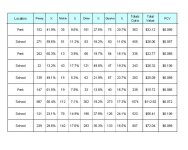z118
Forum Supporter
- Joined
- Sep 30, 2006
- Messages
- 3,180
Okay, so I like to monkey with numbers... there was a nice thread lately about per coin values which I really liked.
I think we've all noticed how some locations seem to have a larger percentage of one type of coins than other locations. At schools I just assume that this is because of the cost of lunches maybe? For instance, if lunch costs $1.50 most kids would most likely bring in $2 and then be inclined to drop quarters at recess. Where as if luch cost $1.80 I would think you'd see more dimes. Just a guess.
Anyway, just for the heck of it I added up the totals for some of the locations I have hunted the most frequently and/or successfully. The numbers certainly bear out that coins spreads are not even close to equal between different locations. For instance:
Pennies range from 13.2% of total coins finds at one site to 61.5% at another.
Nickels range from 3.9% to 17.7%.
Dimes range from 13.8% to 49.8%
Quarters range from 11.0% to 24.1%
Quarters seem to be the most consistent from place to place. I wonder why?
The per coin value for these spots range from $0.057 to $.108 - that's a pretty big range I think.
Anyway, thanks for looking!
I think we've all noticed how some locations seem to have a larger percentage of one type of coins than other locations. At schools I just assume that this is because of the cost of lunches maybe? For instance, if lunch costs $1.50 most kids would most likely bring in $2 and then be inclined to drop quarters at recess. Where as if luch cost $1.80 I would think you'd see more dimes. Just a guess.
Anyway, just for the heck of it I added up the totals for some of the locations I have hunted the most frequently and/or successfully. The numbers certainly bear out that coins spreads are not even close to equal between different locations. For instance:
Pennies range from 13.2% of total coins finds at one site to 61.5% at another.
Nickels range from 3.9% to 17.7%.
Dimes range from 13.8% to 49.8%
Quarters range from 11.0% to 24.1%
Quarters seem to be the most consistent from place to place. I wonder why?
The per coin value for these spots range from $0.057 to $.108 - that's a pretty big range I think.
Anyway, thanks for looking!


